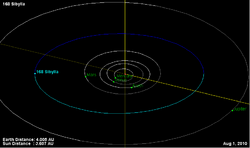Astronomy:168 Sibylla
From HandWiki
Short description: Outer main-belt asteroid
 Orbital diagram | |
| Discovery[1] | |
|---|---|
| Discovered by | J. C. Watson |
| Discovery site | Ann Arbor |
| Discovery date | 28 September 1876 |
| Designations | |
| (168) Sibylla | |
| Pronunciation | /sɪˈbɪlə/[2] |
| Named after | Sibyls |
| A876 SA; 1911 HF; 1949 MO | |
| Minor planet category | main-belt |
| Adjectives | Sibyllian /sɪˈbɪliən/ |
| Orbital characteristics[3][4] | |
| Epoch 31 July 2016 (JD 2457600.5) | |
| Uncertainty parameter 0 | |
| Observation arc | 136.01 yr (49676 d) |
| |{{{apsis}}}|helion}} | 3.6215 astronomical unit|AU (541.77 Gm) |
| |{{{apsis}}}|helion}} | 3.1417 AU (469.99 Gm) |
| 3.3816 AU (505.88 Gm) | |
| Eccentricity | 0.070943 |
| Orbital period | 6.22 yr (2271.4 d) |
| Average Orbital speed | 16.19 km/s |
| Mean anomaly | 171.517° |
| Mean motion | 0° 9m 30.564s / day |
| Inclination | 4.6617° |
| Longitude of ascending node | 205.959° |
| 173.920° | |
| Physical characteristics | |
| Dimensions | 148.39±4.0 km[3] 149.06 ± 4.29 km[5] |
| Mass | (3.92 ± 1.80) × 1018 kg[5] |
| Mean density | 2.26 ± 1.05 g/cm3[5] |
| Rotation period | 47.009 h (1.9587 d) |
| Sidereal rotation period | 23.82 hours[6] |
| Geometric albedo | 0.0535±0.003 |
| C | |
| Absolute magnitude (H) | 7.94 |
168 Sibylla is a large main-belt asteroid, discovered by Canadian-American astronomer J. C. Watson on September 28, 1876. It was most likely named for the Sibyls, referring to the Ancient Greek female oracles.[7] Based upon its spectrum this object is classified as a C-type asteroid, which indicates it is very dark and composed of primitive carbonaceous materials. 168 Sibylla is a Cybele asteroid, orbiting beyond most of the main-belt asteroids.
Photometric observations of this asteroid made at the Torino Observatory in Italy during 1990–1991 were used to determine a synodic rotation period of 23.82 ± 0.004 hours.[6] The shape of this slowly rotating object appears to resemble an oblate spheroid.[8]
References
- ↑ "Discovery Circumstances: Numbered Minor Planets (1)-(5000)". https://www.minorplanetcenter.net/iau/lists/NumberedMPs000001.html. Retrieved August 14, 2012.
- ↑ Sibylla (3rd ed.), Oxford University Press, September 2005, http://oed.com/search?searchType=dictionary&q=Sibylla (Subscription or UK public library membership required.)
- ↑ 3.0 3.1 Yeomans, Donald K., "168 Sibylla", JPL Small-Body Database Browser (NASA Jet Propulsion Laboratory), https://ssd.jpl.nasa.gov/sbdb.cgi?sstr=168, retrieved 12 May 2016.
- ↑ "The Asteroid Orbital Elements Database". Lowell Observatory. http://ftp.lowell.edu/pub/elgb/astorb.html. Retrieved August 14, 2012.
- ↑ 5.0 5.1 5.2 Carry, B. (December 2012), "Density of asteroids", Planetary and Space Science 73 (1): 98–118, doi:10.1016/j.pss.2012.03.009, Bibcode: 2012P&SS...73...98C. See Table 1.
- ↑ 6.0 6.1 di Martino, M. et al. (February 1994), "Lightcurves and rotational periods of nine main belt asteroids", Icarus 107 (2): 269–275, doi:10.1006/icar.1994.1022, Bibcode: 1994Icar..107..269D.
- ↑ Schmadel, Lutz (2003), Dictionary of Minor Planet Names, Physics and astronomy online library, 1, Springer Science & Business Media, p. 30, ISBN 9783540002383, https://books.google.com/books?id=VoJ5nUyIzCsC&pg=PA30.
- ↑ Wang, Xiaobin et al. (January 2016), "Studies for slowly rotating asteroids (168) Sibylla and (346) Hermentaria", Asteroids: New Observations, New Models, Proceedings of the International Astronomical Union, IAU Symposium 318: pp. 185–192, doi:10.1017/S1743921315008777, Bibcode: 2016IAUS..318..185W.
External links
- 168 Sibylla at AstDyS-2, Asteroids—Dynamic Site
- 168 Sibylla at the JPL Small-Body Database
 |

